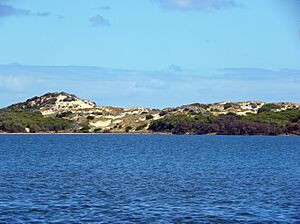Leschenault Estuary facts for kids
The Leschenault Estuary is a large body of water that sits just north of Bunbury, Western Australia. An estuary is a place where a river meets the sea, and the water is a mix of fresh and salt water.
This estuary used to connect to the Indian Ocean through a natural opening called the Leschenault Inlet. However, changes were made to help ships get into Bunbury Harbour. Now, a new opening called The Cut connects the estuary to the ocean, located north of the old inlet.
The Leschenault Estuary is about 13.5 kilometres (8.4 miles) long. At its widest point, it stretches about 2.5 kilometres (1.6 miles) across. The total area of the estuary is about 25 square kilometres (9.7 square miles). A narrow strip of sand dunes, known as the Leschenault Peninsula, separates the estuary from the ocean.
Where the Water Comes From: The Catchment Area
The land area that collects and channels water into the Leschenault Estuary is called its catchment. This area covers about 1,981 square kilometres (765 square miles).
The catchment includes different types of land. These are the Swan Coastal Plain, the Darling Scarp (a steep slope), and the Darling Plateau (a flat, high area).
The main rivers that feed into the estuary are the Collie River and the Preston River. They flow into the southern part of the estuary. All the water from the catchment eventually flows into the Indian Ocean through The Cut.
Other rivers that contribute water include the Brunswick River, Ferguson, and Wellesley. Many smaller creeks and streams also flow into the estuary.
A large number of people live in the catchment area, with a total population of about 65,000. Much of the land has been cleared for farming and some light industry. However, about 40% of the natural vegetation still remains.
A Look Back in Time: History of the Estuary
The Leschenault Estuary began to form about 7,000 years ago. At that time, the coast between Mandurah and Bunbury was a rocky limestone shore.
Over thousands of years, sand dunes started to build up along the coast. These dunes created a long, sheltered lagoon that stretched from the current estuary all the way north to Lake Preston. This lagoon was mostly separated from the ocean.
Around 4,500 years ago, the dune system connected with the eastern side of the estuary. This split the lagoon into two parts. The northern part eventually filled with mud, leaving the southern section as the estuary we see today.
The construction of 'The Cut' was a big project. This new opening, which connects the estuary to the ocean near the Collie River mouth, started in February 1950.
In 2013, some unusual packages were found in the inlet. Experts safely removed these items through controlled explosions.
Amazing Nature: Flora and Fauna
The Leschenault Estuary is home to a special colony of white mangroves. These are the most southern mangroves found in Western Australia. Scientists believe they are around 2,500 years old!
These mangroves cover an area of about 6.4 hectares (16 acres). A special boardwalk has been built around the mangrove colony. This allows visitors to walk through the area and learn about these unique plants from informative signs.
The estuary is also a very important place for waterbirds. Up to 62 different kinds of waterbirds use the estuary as their home. They mostly find their food in the tidal salt-marshes, which are areas of land that are sometimes covered by salty water.
The estuary also acts as an important nursery area for many types of fish. This means it's a safe place for young fish to grow before they move into the ocean.


